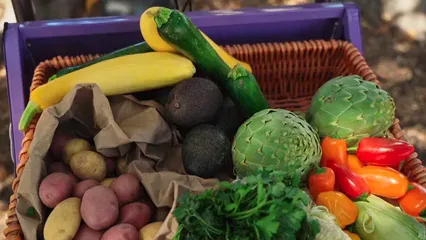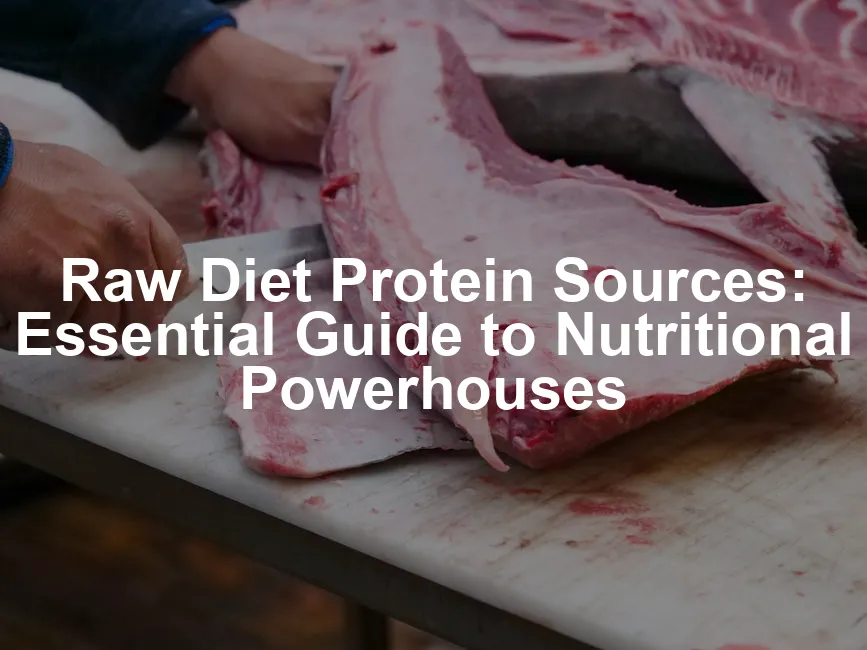Introduction
A raw diet emphasizes unprocessed foods. This approach focuses on consuming fresh fruits, vegetables, nuts, and seeds. Protein sources play a vital role in maintaining health and energy levels. As more people seek healthier lifestyles, raw diets are gaining popularity among health enthusiasts.
Summary and Overview
A raw diet consists mainly of uncooked and unprocessed foods. The core principles include eating fresh produce, nuts, seeds, and sprouted grains. Unlike cooked sources, raw protein retains more nutrients. This means you get maximum benefits from your food.
Protein is essential for building and repairing tissues. It supports muscle growth and immune function. Raw protein sources can enhance nutrient density, boost energy, and improve digestion.
However, obtaining sufficient protein can be challenging on a raw diet. It’s crucial to include a variety of foods to meet nutritional needs. This variety helps ensure you’re consuming enough protein and other essential nutrients. With thoughtful planning, you can enjoy the many benefits a raw diet offers.

Benefits of Raw Diet Protein Sources
Raw protein sources offer numerous health benefits. Consuming these foods helps maintain a healthy weight. Raw diets are often lower in calories, making it easier to shed unwanted pounds.
These diets also support improved digestion. Raw foods are rich in fiber, promoting gut health and regularity. Additionally, many raw foods contain enzymes that aid digestion, further enhancing nutrient absorption.
Energy levels can experience a significant boost from a raw diet. Fresh, unprocessed foods supply your body with essential vitamins and minerals. These nutrients contribute to increased vitality and overall well-being.
Another perk of raw protein sources is their antioxidant properties. Raw foods retain more nutrients, protecting against oxidative stress. This preservation of nutrients helps combat inflammation and supports immune health.
Incorporating raw protein sources into your diet can lead to a healthier, more energetic lifestyle. For more information on the benefits and guidelines of a raw diet, check out this prey model raw diet.
Looking to satisfy your sweet tooth while keeping it healthy? Try raw protein bars that are perfect for a quick snack or post-workout treat. They’re packed with nutrients and are sure to keep you energized!
Understanding the benefits of a raw diet can enhance your approach to nutrition. Learn more about the prey model raw diet.
Key Raw Protein Sources
Raw Plant-Based Protein Sources
When it comes to raw plant-based proteins, several options stand out.
- Nuts and Seeds: Almonds, walnuts, chia seeds, and hemp seeds are excellent sources. Almonds provide healthy fats and protein, while walnuts are rich in omega-3s. Chia seeds offer fiber and essential minerals, and hemp seeds are a complete protein, containing all necessary amino acids.
- Legumes: Sprouted lentils and chickpeas are perfect choices. Sprouting enhances nutrient bioavailability, making these legumes easier to digest. They are also packed with protein and fiber, promoting satiety and digestive health.
- Grains: Quinoa and sprouted brown rice are nutritious options. Quinoa is a complete protein and gluten-free, while sprouted brown rice contains more vitamins and minerals than its cooked counterpart. Both grains can be incorporated into salads or consumed with raw vegetables.

These raw plant-based protein sources are not only nutritious but also versatile, making them easy to include in meals. By integrating a variety of these foods, you can ensure adequate protein intake while enjoying a diverse and vibrant diet.
Raw Animal-Based Protein Sources
For those who choose to include animal products in their raw diet, several options provide valuable protein.
- Raw Eggs: Rich in protein and healthy fats, raw eggs are nutrient-dense. They contain essential vitamins and minerals. However, it is essential to source high-quality eggs to reduce the risk of salmonella.
- Raw Dairy: Options like raw milk and yogurt offer beneficial bacteria and enzymes. These foods can support gut health and provide calcium. Look for high-quality, grass-fed options to maximize health benefits. Consider using a raw dairy milk for your smoothies!
- Raw Fish and Meat: Consuming raw fish and meat can be nutritious, providing high protein levels and healthy fats. However, safety is paramount. Always choose high-quality, fresh ingredients, and consider freezing fish beforehand to eliminate parasites.

While raw animal products can enhance your diet, consider ethical and health implications. Sourcing responsibly and practicing safe food handling techniques will help ensure a positive experience.
Incorporating both plant-based and animal-based raw protein sources can lead to a well-rounded, nutritious diet that supports your health and wellness goals.
How to Incorporate Raw Protein Sources
Incorporating raw protein sources into your meals can be both fun and nutritious. Start by adding nuts and seeds to your snacks or salads. They’re packed with healthy fats and protein. Consider making smoothies with chia seeds or hemp seeds for an easy breakfast boost. You can also mix sprouted lentils or chickpeas into salads for extra texture and nutrition.
Consider this sample meal plan:
- Breakfast: Smoothie with banana, spinach, and hemp seeds
- Snack: A handful of almonds and a piece of fruit
- Lunch: Quinoa salad with diced vegetables and sprouted lentils
- Snack: Carrot sticks with raw hummus
- Dinner: Zucchini noodles topped with raw marinara sauce

Variety is key! Different protein sources provide unique nutrients and benefits. Balance your meals with a mix of plant-based proteins, ensuring you meet your dietary needs.
Tips for Transitioning to a Raw Diet
Transitioning to a raw diet can be smooth with the right approach. Start gradually by incorporating more raw foods into your meals. For instance, swap one cooked meal for a raw option each week. Meal prepping can also help—chop fruits and veggies ahead of time for quick access.
When it comes to storage, keep your raw foods organized and visible. This encourages healthier choices. Always listen to your body during this transition. If you feel hungry or fatigued, adjust your intake accordingly. Experimenting with different recipes can keep your meals exciting and flavorful.
For those looking to streamline their meal prep, consider investing in meal prep containers. They make it easy to store and pack your healthy raw meals for the week!

Potential Challenges and Considerations
Adopting a raw diet comes with its own set of challenges. Nutritional deficiencies can arise, especially in protein and essential vitamins. Planning your meals carefully can help avoid these gaps. Consider including a variety of foods to ensure you meet all your nutrient requirements.
Another challenge is food safety. Raw foods, particularly animal products, can carry risks of foodborne illness. Always choose high-quality sources and practice safe food handling. Being mindful of these challenges can lead to a rewarding experience with your raw diet.
To help you measure your portions and ensure balanced meals, consider using a food scale. It can be a game changer in your raw diet journey!

Nutritional Deficiencies
Following a raw diet can lead to nutritional deficiencies. Protein intake may be insufficient, especially if you rely too heavily on fruits and vegetables. Essential vitamins like B12, D, and calcium are often lacking. These nutrients are crucial for bone health, energy, and overall well-being.
Planning is vital to avoid nutrient gaps. Incorporate a variety of foods to ensure a balanced intake. Include raw nuts, seeds, and sprouted legumes for protein. Adding fortified foods can also help. Look for plant-based calcium supplements to boost your intake!
Supplements can be beneficial, especially for vitamin B12. This vitamin is primarily found in animal products. Consider taking a B12 supplement or incorporating raw dairy products if your diet allows. Always consult a healthcare professional before starting any supplements to ensure they meet your specific needs.

Safety and Foodborne Illness
Food safety is a significant concern in raw diets. Consuming raw animal products can increase the risk of foodborne illnesses. Bacteria like Salmonella and E. coli can thrive in these foods. To minimize risks, it’s crucial to handle and store food properly.
Always wash fruits and vegetables thoroughly. When dealing with raw animal products, ensure they come from reputable sources. High-quality ingredients reduce the likelihood of contamination. If possible, choose organic or locally sourced products.
Additionally, practice safe food handling techniques. Use separate cutting boards for raw meat and other foods. This prevents cross-contamination. Regularly clean your kitchen and utensils to maintain a safe environment. Following these guidelines can help you enjoy the benefits of a raw diet while minimizing health risks.

Conclusion
In summary, a raw diet can offer many health benefits, but it requires careful planning. Nutritional deficiencies are a real concern that can impact your health. It’s crucial to select a variety of raw protein sources and consider supplementation when necessary.
Prioritizing food safety is equally important. Always source high-quality ingredients and practice safe food handling. A raw diet can be a viable option for health and wellness, but remaining mindful of your nutritional needs is essential for success. Explore raw diets with confidence by planning and preparing wisely.
Don’t forget to hydrate! An insulated water bottle can keep your drinks cold, ensuring you drink enough throughout the day!
FAQs
What are the best raw protein sources?
Finding the right protein sources is key on a raw diet. Here are some top options: Plant-Based: Nuts and Seeds: Almonds, walnuts, chia seeds, and hemp seeds are nutrient-rich. These provide healthy fats and protein. Legumes: Sprouted lentils and chickpeas are excellent. Sprouting increases digestibility and nutrient absorption. Grains: Quinoa and sprouted brown rice are great choices. They offer complete proteins and essential minerals. Animal-Based: Raw Eggs: Packed with protein and healthy fats, raw eggs should come from high-quality sources. Raw Dairy: Options like raw milk and yogurt contain beneficial bacteria for gut health. Raw Fish and Meat: Fresh, high-quality fish and meat provide rich protein but require careful handling.
Is a raw diet healthy?
A raw diet can offer several health benefits. It often includes higher amounts of fresh fruits and vegetables, boosting nutrient intake. Many people report improved digestion and energy levels. However, there are risks. Nutrient deficiencies can occur, especially in proteins and vitamins like B12. Individuals may also face challenges with food safety. It’s vital to plan meals carefully and choose high-quality ingredients. Consulting a healthcare professional can help you navigate these concerns.
How can I get enough protein on a raw diet?
Meeting protein needs on a raw diet is possible with thoughtful planning. Here are some tips: Incorporate Variety: Include a mix of nuts, seeds, legumes, and grains to ensure you get all essential amino acids. Meal Prep: Plan your meals ahead of time. This helps you stay on track and ensures you have ample raw protein sources available. Use Smoothies and Salads: Add protein-rich ingredients like hemp seeds or sprouted lentils to smoothies and salads for an easy nutrient boost.
Can I include cooked foods in a raw diet?
A raw diet focuses exclusively on uncooked, unprocessed foods. Foods are typically not heated above 104-118°F. This includes fruits, vegetables, nuts, seeds, and sprouted grains. Some people may choose to include lightly cooked foods, but this strays from strict raw diet principles. If you decide to add cooked items, aim for minimal processing to maintain the diet’s health benefits.
What are the risks of eating raw animal products?
Consuming raw animal products can pose health risks. Raw meat, fish, and dairy may harbor harmful bacteria, such as Salmonella or E. coli. To minimize these risks, always choose high-quality, fresh ingredients from reputable sources. Freezing fish before consumption can help eliminate potential parasites. It’s essential to practice safe food handling and maintain cleanliness in preparation areas.
How do I transition to a raw diet?
Transitioning to a raw diet can be smooth if approached gradually. Here are some helpful steps: Start Slow: Begin by replacing one cooked meal with a raw option each week. This makes the change less overwhelming. Meal Prep: Prepare and store raw fruits and vegetables in advance. This ensures you have convenient options when hunger strikes. Listen to Your Body: Pay attention to how you feel during the transition. Adjust your food intake as needed to maintain energy and satisfaction. Experiment with different recipes to keep meals exciting and enjoyable.
Please let us know what you think about our content by leaving a comment down below!
Thank you for reading till here 🙂
All images from Pexels





